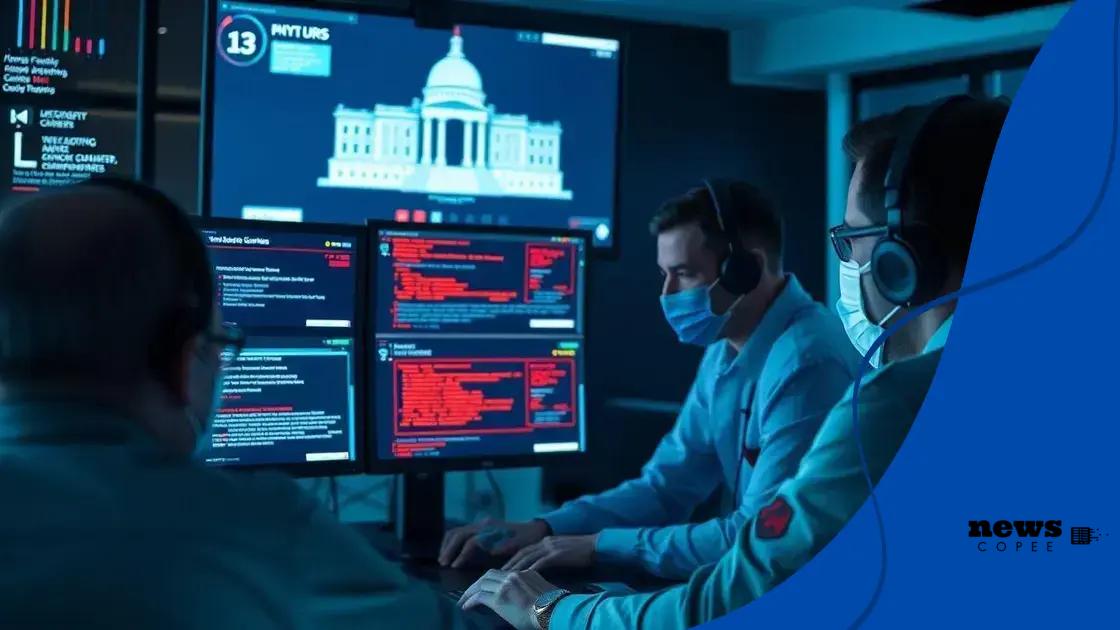Cybersecurity threats and government responses addressed

Cybersecurity threats and government responses involve adapting strategies through AI integration, enhanced regulations, and international cooperation to effectively protect against evolving cyber risks.
Cybersecurity threats and government responses addressed have become increasingly important in our digital world. With the rise in cyber attacks, how are governments evolving to protect us all? In this article, we’ll delve into what these threats entail and the responses crafted to keep us safe.
Understanding the landscape of cybersecurity threats
Understanding the landscape of cybersecurity threats is crucial for both governments and individuals. Cyber threats come in various forms and can impact anyone, from large organizations to everyday users. By recognizing the types of threats, we can take proactive measures to defend against them.
Types of Cybersecurity Threats
Cybersecurity threats can be classified into several categories. Some of the most common include:
- Malware: This includes viruses, worms, and Trojans designed to disrupt, damage, or gain unauthorized access to systems.
- Phishing: A tactic used by cybercriminals to trick users into providing sensitive information through deceptive emails or websites.
- DDoS Attacks: These involve overwhelming a network or website with traffic, rendering it unavailable.
- Ransomware: A type of malware that encrypts data, demanding payment for its release.
Each of these threats poses unique challenges for cybersecurity frameworks. Governments around the world recognize the importance of being vigilant against these risks. They implement various measures to bolster defenses and educate citizens about safe practices.
Rising Sophistication of Attacks
The sophistication of cyber attacks has significantly increased. Hackers continuously develop new techniques, which makes it essential for defensive strategies to evolve. For instance, the use of artificial intelligence in cyber attacks can automate and optimize the process of discovering vulnerabilities.
Governments are responding to these challenges by investing in research and development for advanced cybersecurity solutions. Collaborative efforts with private industries help in strengthening defenses against these complex threats. By working together, we can share knowledge and resources that provide a more robust defense against cyber adversaries.
Major government strategies to combat cyber threats
Major government strategies to combat cyber threats are essential in keeping citizens and critical infrastructure safe. Governments worldwide are increasingly prioritizing cybersecurity to address the rising rates of cybercrime. By implementing effective strategies, they aim to enhance national security and protect sensitive information.
Collaboration with Private Sector
One of the key strategies involves collaborating with the private sector. This partnership enables sharing of vital information about potential threats. By working together, governments and private companies can develop more effective defenses. The sharing of intelligence helps in preemptively identifying risks and vulnerabilities.
- Joint cybersecurity exercises help improve readiness.
- Information-sharing platforms provide real-time updates on threats.
- Public-private partnerships facilitate innovation in cybersecurity technologies.
Through these collaborations, governments are better positioned to respond to threats quickly and efficiently. Moreover, educational programs initiated in collaboration with organizations raise awareness about cybersecurity best practices among citizens.
Legislation and Regulation
Another crucial aspect of government strategy is the introduction of legislation and regulation aimed at enhancing cybersecurity frameworks. Laws are established to mandate security measures for organizations handling sensitive information. These regulations often include:
- Data Protection Laws: Ensuring organizations implement strong data security protocols.
- Incident Reporting Requirements: Obligating companies to report breaches promptly.
- Cybersecurity Standards: Establishing industry-wide standards for cybersecurity practices.
Such legislation not only enhances security but also holds organizations accountable for their cybersecurity practices. Governments also invest in research and development to stay ahead of evolving cyber threats.
Training and Workforce Development
Training remains a critical element in combating cyber threats. Governments focus on building a skilled cybersecurity workforce. This involves educational programs and initiatives aimed at increasing interest in cybersecurity careers. By fostering talent and expertise, they ensure a pool of professionals ready to tackle future challenges.
Ultimately, a combination of collaboration, legislation, and training forms the backbone of government strategies to combat cyber threats effectively. Together, these efforts create a more resilient digital landscape.
The role of international cooperation in cybersecurity

The role of international cooperation in cybersecurity is increasingly vital in today’s interconnected world. Cyber threats do not respect borders; they require a unified global response. Countries around the globe are recognizing the need to work together to combat these evolving challenges.
Collaborative Frameworks
One major aspect of international cooperation is the establishment of collaborative frameworks. These frameworks facilitate the exchange of information and technology among nations. They help in developing shared protocols for responding to cyber incidents. Key components of these frameworks include:
- Information Sharing: Countries share threat intelligence to stay ahead of potential attacks.
- Joint Exercises: Collaborative training exercises help improve response strategies.
- Legal Frameworks: Agreements establish uniform laws regarding cybersecurity that help prosecute cybercriminals across borders.
By engaging in these collaborative frameworks, nations can strengthen their defenses, making it harder for cybercriminals to exploit vulnerabilities.
Global Organizations’ Role
International organizations play a crucial role in facilitating cooperation on cybersecurity. Bodies such as the United Nations and Interpol coordinate efforts among member countries. They work on establishing guidelines and best practices for cybersecurity. These organizations also help in the coordination of cross-border incident responses.
The collaboration between nations and organizations focuses on building capacity in developing nations. Providing resources and training ensures a baseline level of cybersecurity globally. All nations must be equipped to fend off cyber threats, as vulnerabilities in one country can impact others.
The Importance of Trust
Trust is essential in international cooperation on cybersecurity. Nations must rely on each other to share information honestly and act in good faith. Building this trust involves consistent communication and transparency. Developing strong diplomatic relations also helps foster a more cooperative cybersecurity environment.
Moreover, public-private partnerships are equally significant in this context. Businesses worldwide contribute to national and international cybersecurity efforts. They can share their resources and expertise, further enhancing defenses against cyber threats.
In conclusion, international cooperation plays a fundamental role in the fight against cyber threats. Through collaboration, legal frameworks, and trust, nations can develop stronger defenses, ensuring greater global security in cyberspace.
How local governments are enhancing security measures
Local governments are actively enhancing security measures to protect communities from cyber threats. These enhancements are vital in an era where cyber attacks can significantly disrupt daily life. By implementing strategic initiatives, local governments aim to build resilience and safeguard sensitive information.
Increased Funding for Cybersecurity
One of the key strategies includes increasing funding for local cybersecurity initiatives. This funding allows for the purchase of advanced security tools and the hiring of skilled IT professionals. Local governments are recognizing the importance of allocating budget resources to strengthen their defenses.
- Investment in technology: Upgrading networks and security systems to better protect against attacks.
- Training personnel: Providing ongoing education and training for staff on the latest cybersecurity practices.
- Public awareness campaigns: Educating citizens on protecting themselves from cyber threats.
These funding initiatives enhance the overall security posture of local governments, making them less vulnerable to attacks.
Collaborative Approaches
Local governments are also fostering collaboration with law enforcement agencies and private sector partners. By working together, they can share intelligence and resources. This collaboration is crucial in responding to incidents and identifying potential threats promptly.
Joint exercises between local agencies and private organizations often improve readiness for cybersecurity incidents. Regular meetings and communication channels facilitate a faster response when threats do arise.
Implementing Best Practices
Local governments adopt best practices based on national standards for cybersecurity. This includes developing incident response plans and conducting regular security assessments. These assessments help identify vulnerabilities and areas for improvement.
Furthermore, establishing clear policies and procedures ensures that all employees understand their roles in maintaining cybersecurity. Regular drills and training sessions keep everyone prepared for potential cyber incidents.
In conclusion, local governments are taking significant steps to enhance security measures against cyber threats. Through increased funding, collaboration, and best practices, they work toward a safer environment for their communities.
Future trends in cybersecurity and government response
Future trends in cybersecurity and government response are critical as technology continues to evolve. As cyber threats become more sophisticated, governments must adapt their strategies to protect citizens effectively. Looking ahead, several key trends are emerging that will shape how cybersecurity is approached globally.
Artificial Intelligence and Automation
One significant trend is the increasing use of artificial intelligence (AI) and automation in cybersecurity. Governments are exploring how AI can enhance threat detection and response capabilities. By automating routine tasks, cybersecurity professionals can focus on more complex issues.
- Predictive analysis: AI can help analyze patterns and predict potential cyber attacks.
- Automated responses: Systems can automatically react to certain threats, reducing response time.
- Advanced threat hunting: AI tools enable proactive search for vulnerabilities within systems.
As these technologies develop, the role of cybersecurity personnel may shift, requiring new skills and training.
Enhanced Regulatory Frameworks
With the rise of cyber threats, governments will likely enhance regulatory frameworks to ensure better protection. New regulations may focus on data privacy, breach notification, and cybersecurity standards for organizations.
These frameworks will aim to create a uniform approach to cybersecurity, making it easier to hold organizations accountable. As governments implement these laws, businesses will need to comply, emphasizing the importance of strong security measures.
International Cooperation
International cooperation will remain crucial in combating cyber threats. Global security challenges require collaboration among nations to share information and best practices. Governments will need to engage in more dialogues and joint initiatives to counteract cybercrime effectively.
Through international partnerships, countries can develop better strategies, respond to incidents more effectively, and share resources to enhance collective defense. Programs like these strengthen cybersecurity efforts and improve overall resilience against threats.
As we look to the future, the landscape of cybersecurity will continue to evolve. With a focus on AI, regulatory frameworks, and international cooperation, governments can enhance their preparedness and response to cyber threats.
FAQ – Questions About Cybersecurity and Government Responses
What are the main cyber threats governments face?
Governments face various cyber threats including malware, phishing, ransomware, and DDoS attacks, which can disrupt operations and compromise sensitive data.
How can AI improve government cybersecurity?
AI can enhance threat detection, automate responses to incidents, and analyze large amounts of data to identify potential vulnerabilities before they are exploited.
Why is international cooperation important for cybersecurity?
International cooperation is crucial because cyber threats often cross borders. Collaborating allows countries to share intelligence, resources, and strategies to better combat these threats.
What can local governments do to enhance cybersecurity?
Local governments can increase funding for cybersecurity initiatives, engage in public awareness campaigns, and collaborate with both private sectors and other governmental agencies.
